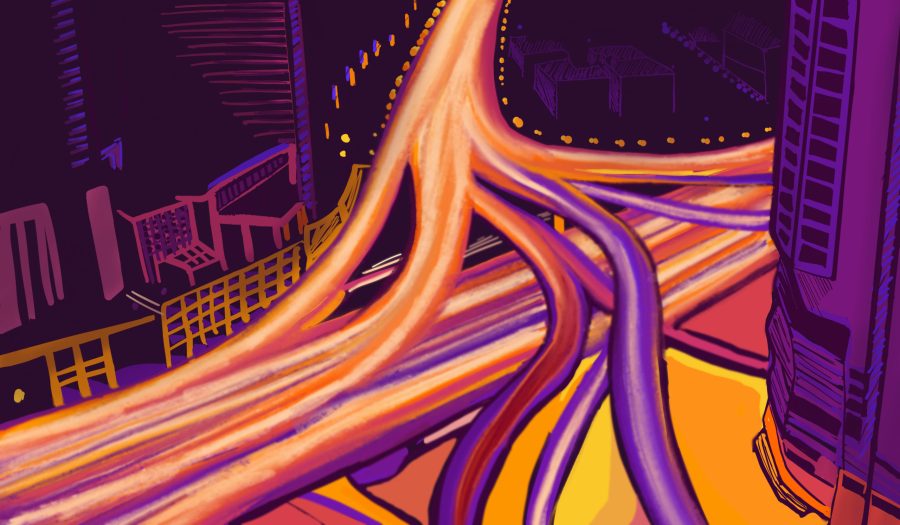It is generally agreed upon that public transportation is more energy efficient, which is an asset in decreasing global emissions. However, most Americans do not use public transportation for various reasons. Perhaps it is because public transportation in America is seen as an unbalanced tradeoff: merely decreasing emissions at the cost of convenience, personal privacy, and safety. In reality, public transportation offers increased convenience, safety, and reduced costs. Because these benefits increase with ridership, if more Americans realize the benefits of public transportation, many new doors will open.
Many Americans prefer cars over public transportation because of the convenience of being able to drive right to your destination. However, America’s reliance on cars is a self-reinforcing, vicious cycle that is ultimately unsustainable. Even now, we are experiencing the effects in the form of traffic jams and high housing costs.
Cars require parking space, which takes up limited land that could be repurposed for housing or green space. According to Vox, “It’s estimated that in America, there are 8 parking spots for every car, covering 30% of our cities, and collectively taking up about as much space as the state of West Virginia.” What’s worse is that most of this parking space is unused. Think of the parking lots around retail outlets or big box stores. These spaces are only used at full capacity during peak times. Most of the time they are nearly empty. Ironically, there are many homeless people struggling to find a place to sleep at night. But jacking up housing prices and contributing to homelessness is not the only negative impact of car reliance.
The dead space taken up by parking lots also extends the distance between locations. The added distance means increased reliance on cars and subsequently more parking lots. To demonstrate car reliance created by parking lots, I know people who go to shopping outlets and drive their cars to the closest parking spots to each store they visit instead of parking once and walking. Thus, the dead space in a single parking lot already makes some reliant on cars. Added distance also means burning more gas and added travel time.
A more obvious issue with cars are traffic jams. Increased usage of public transportation will mitigate this problem. However, one may argue that technologies can mitigate traffic jams while still allowing for continued reliance on cars as private transportation. For example, self-driving cars may travel more efficiently in groups, or Elon Musk’s proposed underground highways may allow transportation to take place in three dimensions. However, no matter how efficient private car transportation gets, it will never be as efficient as public transportation. Private cars will always have the issue of parking dead space, and if we do develop large-scale tunneling technologies, that means public transportation can also go 3D, thus retaining its efficiency advantage over private cars.
A city built around public transportation is more convenient. Distances are shorter from reduced dead space, and there is no need to worry about not finding a parking spot. However, one may point out that many American cities are not built with public transportation in mind, and that it is not easy to tear the whole city down and start from scratch. In addition, public transportation such as rail transport requires more intensive infrastructure and higher initial costs. Despite the benefits of public transportation, these are significant barriers to implementing more reliable forms of public transportation.
Another major concern of public transportation is safety. You are stuck in a cabin with strangers. There might be someone with a contagious disease. These concerns are potentially mitigable and a proposed solution will be addressed later in the article. However, even now, Asian countries have a good track record of safely and reliably transporting millions, demonstrating that public transportation can be consistently safe. According to Nippon.com, based on 2017 data from the Central Japan Railway Company annual report, the Tōkaidō Shinkansen “has not experienced any passenger fatalities from accidents like collisions, derailing, or fire” since its debut in 1964, and remains one of the heaviest used high speed rail lines in the world.
On the other hand, cars are not as safe as you may think. According to the CDC, “Road traffic crashes are a leading cause of death in the United States for people aged 1–54, and they are the leading cause of non-natural death for U.S. citizens residing or traveling abroad.” In short, locking yourself in your own private car does not protect you from bad drivers, or from yourself if you’re one of them. People need to be attentive while driving, which again shows how inconvenient cars are: in cars, you can’t multitask like on public transportation without risking lives. While one may argue that self-driving cars eliminate this issue, since cars are not constrained by tracks, there is still a greater chance of unpredictable things happening, such as sudden animal crossings or black ice on the road that make it hard for current automation, or human ability, to deal with.
Another issue with cars is that they are expensive and American reliance on cars puts low-income individuals at a disadvantage, presenting a barrier to social mobility. According to the Bureau of Transportation Statistics, “households with an annual income of less than $25,000 are almost nine times as likely to be a zero-vehicle household than households with incomes greater than $25,000.” I suspect this is due to a dilemma for low-income individuals: to get a car and gain access to better jobs, one has to cope with expenses such as the initial cost, gas, maintenance, and insurance. Data from the Bureau of Labor Statistics seem to support this hypothesis: Americans in 2020 had an average expenditure of $9826 on transportation, with only $263 accounted for by public transportation, leaving the rest presumably to cars. According to the same document, housing takes up the most expenditure, followed by transportation. Seeing how cars jack up housing prices through dead space and car transportation itself is expensive, this means that cars increase the two most significant expenditure categories.
Reliance on cars restricts mobility and independence of many individuals. The young and old need to be chaperoned, making them dependent on people who may also be busy, presenting a lose-lose scenario. Take the example of a kid needing a parent to drive them to an hour-long event 15 minutes away. The parent will probably end up waiting for the kid since running two 30-minute roundtrips for an hour-long event does not make sense. While one may argue that having self-driving cars solves this problem, this means that there needs to be at least one car per family member to provide the same individual flexibility during rush hour. According to the Bureau of Transportation Statistics, “while the mean number of vehicles in households is 1.9 personal vehicles, households in the United States on average have 1.8 drivers who are 15 years or older.” The US already has more cars than drivers on average, and the thought of giving everyone their personal car would not only be prohibitively expensive for most families, but add even more dead space, making travel even less convenient.
To address the initial cost of public transportation, making it more efficient can help it break even. To this end, humans and material cargo may be transported together. Currently, buses and trains often run empty. Anything that is not running at full capacity is not running optimally. Notice that both buses and delivery trucks run regular routes with regular stops. The only difference is whether it’s people or things being picked up and dropped off. Think of the proposed solution as carpooling with cargo in addition to people. If the two can be combined, transportation of both people and material can be more efficient, which saves money, which helps break even with the more expensive initial costs of infrastructure. Take the trolley for example. It costs a fortune and is often empty. Even if we got to the point where people use it as their primary means of travel, the trolley will still not be at full capacity when it is not rush hour. Now consider if packages are delivered to lockers situated at trolley stations during non-rush hours. This will make things more convenient for people because they will receive their internet orders faster and revenue can be generated by this delivery service, helping to break even.
To address the privacy and safety concerns, human and material dual transport goes along with my vision of containerization of public transport. People who are concerned about privacy and safety want to be partitioned from strangers in their own little space. Currently, a big appeal of cars is the ability to customize. A car can be thought of as a small private lounge on wheels. One can install speakers, heated seats, TVs, etc, all the while being separate from the peeling eyes of strangers and being able to see the scenery outside. To offer the same benefits while being compatible with public transportation, private customizable boxes with multi-modal transport capabilities may be used. While currently unsupported, potential technology for the future may allow these boxes to be transported on trains and cars, with a system to transfer between the two modes.This creates a compromise between private and public transport. Of course, the box system can still work in parallel with mass public transport. For example, each train can modularly carry different boxes including cargo boxes, small private people boxes, and large public people boxes. In addition, a box is much more affordable than a car and should last longer due its simplicity, allowing people to invest in highly customizing their transportation experience.
The current issue is not justifying the benefits of public transportation, which are already well documented, but justifying the additional expense of switching from a system primarily geared towards private to public transportation. A proposed solution is to increase efficiency by carrying both people and materials to ensure vehicles are running at full capacity, thus maximum efficiency, at all times. Containerization can facilitate this dual people-material purpose as well as allow individuals to preserve their privacy and safety and affordably customize their travel experience. While public transportation requires high infrastructure costs, Americans need to realize their reliance on cars is a suboptimal and unsustainable solution that is perhaps already costing more than what public transportation would. Therefore, more effort should be placed on novel solutions to make public transportation more economical, thus realizable.
Art by Ava Bayley for the UCSD Guardian.
















backrooms • Jun 19, 2023 at 7:59 pm
To address the privacy and safety concerns, human and material dual transport goes along with my vision of containerization of public transport.